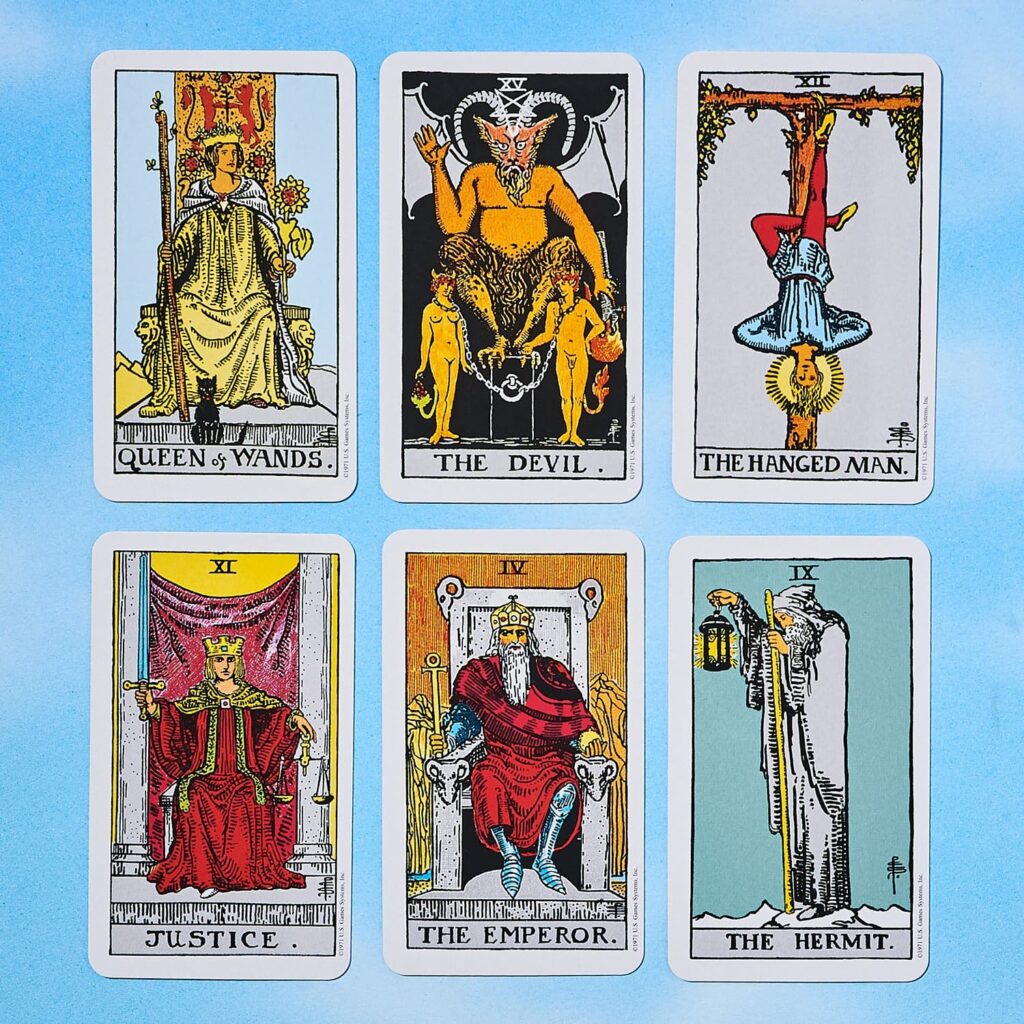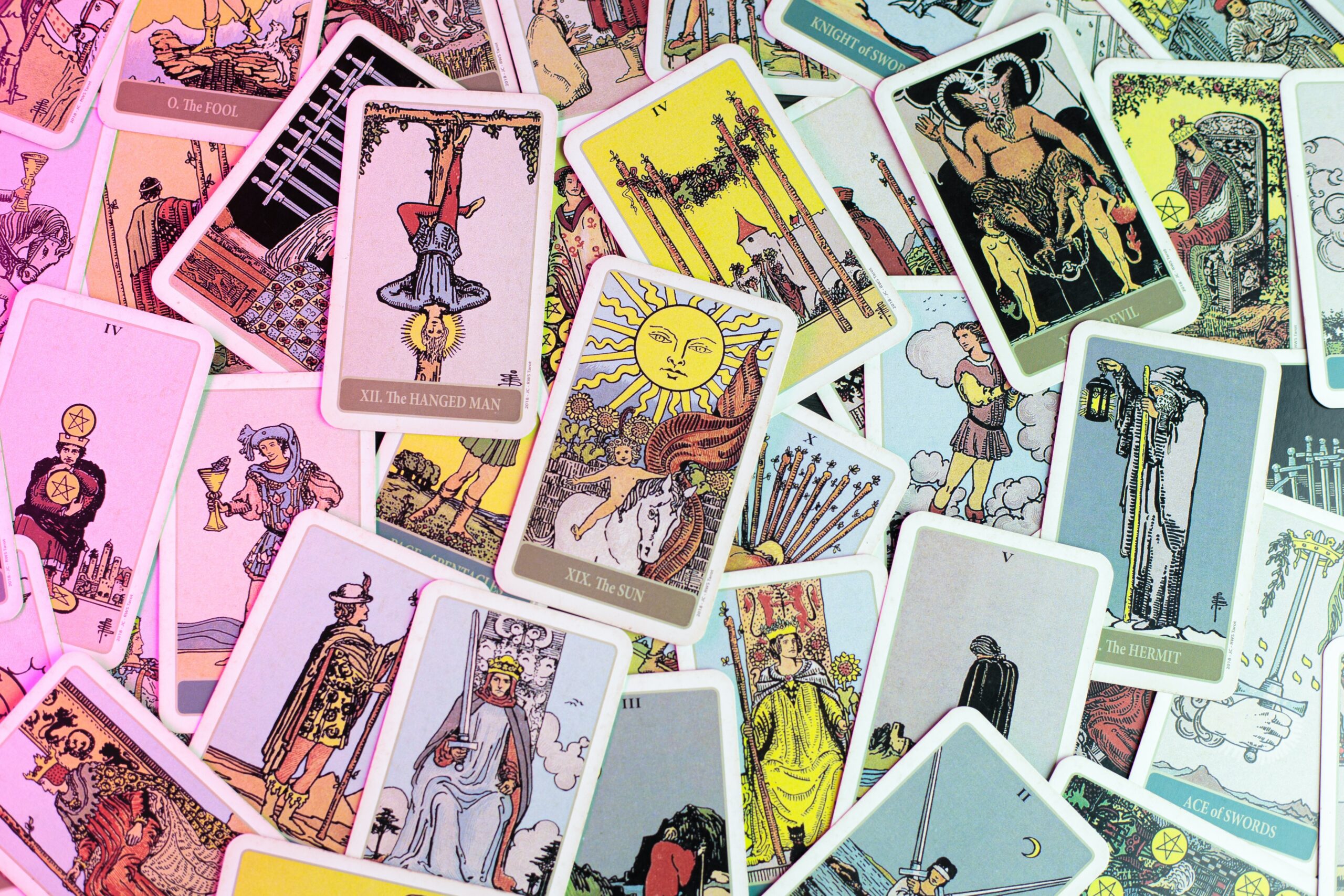Tarot cards are known for future predictions, however, as a beginner tarot reader, who wants to learn tarot (like you maybe?), you need to know that tarot cards are not just for future predictions. They don’t predict the future, they predict the possible future, which is influenced by factors such as the situation at hand, present energy and so much more. Reading tarot for yourself is exciting for sure, but it needs immense practice and dedication.
While you’re at it, learn some more about tarot history.
The format of tarot cards typically includes a deck of 78 cards, divided into two main categories: the Major Arcana and the Minor Arcana.
- Major Arcana: The Major Arcana consists of 22 cards that represent significant life lessons, archetypes, and universal themes. Each card has a unique name, number, and illustration that represents a powerful spiritual or psychological message.
- Minor Arcana: The Minor Arcana consists of 56 cards divided into four suits: Cups, Pentacles, Swords, and Wands. Each suit represents a different aspect of life, such as emotions (Cups), material wealth (Pentacles), communication (Swords), and creativity (Wands). The Minor Arcana cards have numbered cards from Ace to 10, and four court cards: Page, Knight, Queen, and King.

Tarot cards typically have detailed imagery, symbols, and colors that represent a particular concept or meaning. The cards can be used in a variety of spreads or layouts, each with its own specific purpose or focus. Some common tarot spreads include the Celtic Cross, Three-Card Spread, and the Horseshoe Spread.
It’s worth noting that while most tarot decks follow the same general structure, there are many different artistic interpretations of the cards. Some decks feature modern or abstract illustrations, while others have a traditional or historical aesthetic.
Choose a deck that resonates with you and your personal style.
Now that you’ve made a decision to read tarot cards for yourself, here is a quick, effective guide for not just reading, but understanding tarot cards.
Before you start reading tarot, don’t forget to get your FREE Tarot Practice Bundle!
Reading tarot cards involves a combination of knowledge, intuition, and interpretation. Here’s a step-by-step guide on how to read tarot cards:
Select a Tarot Deck: Choose a tarot deck that resonates with you. Personally, I would suggest you go with whatever tarot deck you feel attracted to. It doesn’t have to be the cliche Rider-Waiter, it could be Mystic Mondays, Wild Unknown, Light Seers or many others.
Familiarise Yourself with the Cards: Take time to study each card and its symbolism. Pay attention to the imagery, colors, numbers, and suits. Learning the meanings of the cards is not as important as understanding the Fool’s Journey. The tarot deck starts with The Fool, and the whole deck depicts his story. You need to be able to catch this journey while studying the deck.
Set the Mood: Create a calm and focused environment for your reading. You may light candles, play soft music, or meditate to clear your mind. The motive of doing this is to create a noise-free environment inside your mind. You want to be able to use your intuition to understand/pull meaning out of the cards.
Shuffle the Deck: Shuffle the cards while focusing on your question or area of interest. You can also ask the tarot to provide guidance or insight.
Draw the Cards: Depending on the spread you choose, draw a specific number of cards from the deck. Common spreads include the Three-Card Spread (past, present, future) or the Celtic Cross Spread (provides a comprehensive view of a situation). As a beginner tarot reader, please do not jump to the Celtic Cross immediately. You can find more spreads in your Tarot Practice Bundle.
Interpret the Cards: Look at each card individually and consider its symbolism, imagery, and position in the spread. Reflect on how the card’s meaning relates to your question or situation. Trust your intuition and personal connection with the cards. As I pointed out before, tell the story in the cards, that’s really going to make your work a lot easier.
Apply Personal Insight: Apply your personal knowledge, experiences, and intuition to the interpretation. Tarot is a tool for self-reflection, and your insights are valuable in understanding the message of the cards.
Reflect and Take Action: After the reading, take time to reflect on the messages and guidance you received. I would suggest you to maintain a Tarot Journal, to keep a track of all the readings at least in the beginning of your journey. Tarot can provide insights, but ultimately, you have the power to make choices and take action.
Remember, reading tarot is an ongoing learning process. The more you practice and develop your connection with the cards, the deeper your readings will become. Trust your intuition and enjoy the journey of exploring the symbolism and wisdom of tarot.
Reading tarot for yourself can be a useful tool for gaining insight and clarity about different aspects of your life. However, it can also be challenging because it can be difficult to remain objective and avoid projecting your biases and desires onto the cards.

One difficulty that a lot of beginner tarot readers face is their own BIAS. It can be easy to interpret the cards in a way that supports your desires or biases. Try to remain objective and consider other possible interpretations of the cards. With practice, you will learn how to interpret the cards as a whole, without putting too much effort in each card.
Above all of this, if you are familiar with astrology/numerology, that will also work wonders for you. This is not a predisposition to reading tarot for yourself, but just a preference or should I say an advantage.